Panasonic TX-P50ST50 Review
Panasonic TX-P50ST50
A fantastic Plasma TV to keep LED telly boxes at bay.
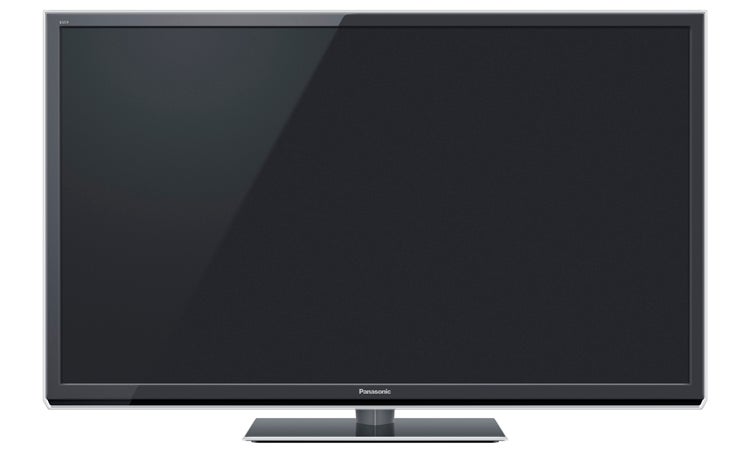
Verdict
Pros
- Outstanding cinematic picture quality
- Stable and attractive online system
- Fair value
Cons
- Requires more power than LED equivalents
- Not ideal for bright rooms
- Could do with a few more online video services
Key Specifications
- Review Price: £1049.00
- 50in plasma screen
- Active 3D
- Full HD resolution
- Viera Connect online service
- Built-in Wi-Fi
These are tough times for plasma technology. From one side it’s getting attacked by the latest LED and, soon, OLED screen technology, while on its other flank it’s having to fend off the draconian ramifications of the latest round of energy consumption rules from the EU and parts of America. It’s fair to say, then, that there’s a fair bit of pressure on the shoulders of Panasonic’s first plasma TV of 2012, the 50in P50ST50.
Design
It’s good to find the Panasonic P50ST50 getting off to a decent start courtesy of a rather pleasant design. The bezel’s deep grey colour is distinctive and eye-catching, and its glass-like finish and 6mm or so of transparent outer trim are both very pretty. The chassis is exceptionally robust too, and while its rear depth is a bit more substantial than you get with some edge-LED models, it’s actually more than slim enough to allow you to easily wall-hang the set.
Wall hanging is further supported by the way the set’s AV connections are accessed from the side or below. Rather bizarrely, though, the kettle lead power socket sticks right out of the back of the TV, and although the provided cable is designed to let it hang down at right angles from the rear panel, there’s still a fairly substantial chunk of protruding ‘plug’ for prospective wall hangers to have to work around.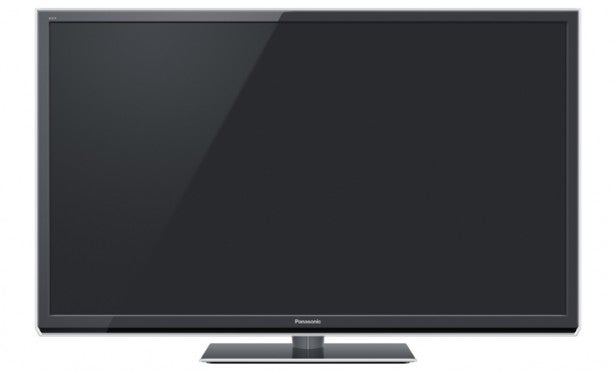
Connectivity
The AV connections are solid rather than scintillating. Our main issue is that you only get three HDMIs when most TVs deliver four these days. But you do get a respectable two USBs for multimedia playback and an Ethernet port for networking the TV to a DLNA-enabled PC or broadband router. What’s more, Panasonic has put right a notable wrong of many of its 2011 TVs by building Wi-Fi into the P50ST50’s chassis. Hallelujah.
The multimedia playback mentioned earlier includes JPEG, AVCHD, SD-Video, MOV, AVI, DivX, MKV, ASF, MP4, FLV, 3GPP, MP3, AAC, WMA, FLAC, PS, and TS file formats (though some of these can only be played when using Windows 7 as a media server). This marks a pleasing growth in Panasonic’s file format support from 2011’s TVs.
We should add too that as well as playing back multimedia files from USB sticks (and, actually, SD cards), you can also record to them from the TV’s built-in Freeview HD tuner.
Key Screen Specs
Turning to the Panasonic P50ST50’s other key specs, the single most important one is that it uses one of Panasonic’s new NeoPlasma panels (TVs lower down the range use previous versions of the technology). This means that the ST50 series models benefit from the latest phopshor and power efficiency improvements – in fact, the ST50 series is reckoned to use 30 per cent less running power than last year’s equivalent models. Even so, though, the screen only bags a ‘C’ rating using the new TV energy grading scale. Panasonic’s recently tested L42ET5 LED TV, by comparison, scored A .
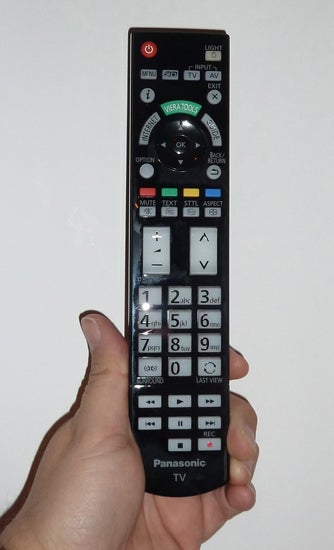
Personally, we don’t have a problem with the P50ST50’s slightly higher power consumption if the result is better picture quality. But it’s a fact we feel duty bound to report.
The P50ST50 boasts ‘2000Hz’ sub-field driving (a big rise from last year’s 600Hz figure) to boost motion reproduction and image stability, as well as enjoying a high contrast filter and a new, improved audio system comprising eight micro speakers firing through a narrow opening across the bottom of the TV.
The P50ST50’s screen enjoys a full HD resolution, naturally, and it’s equally as inevitably equipped with Panasonic’s active 3D technology. It’s a pity you don’t get any active shutter glasses included for free, mind you. After all, the TV isn’t really a 3D TV until you’ve bagged at least one pair of glasses.
Then again, Panasonic would doubtless argue that they’d rather make the P50ST50 as affordable as possible for people who might not care about 3D rather than force everyone to pay for a feature they might not intend to use. And in any case, we’ve seen the necessary TY-ER3D4ME glasses going for as little as £50 a pair.
While we’re on the subject of the P50ST50’s optional 3D glasses, the pair we obtained for this review are yet another new design. Crucially they use RF technology rather than the previous infra-red system, and they’re considerably lighter than Panasonic’s previous efforts – just 27g. They also thankfully sit lower on your nose than the previous models, handily reducing the need to tilt your head down to watch 3D.
Picture settings
The Panasonic P50ST50 is adequately rather than exhaustively equipped with picture calibration aids. Activate an Advanced picture menu and you get White Balance and Gamma adjustments, alongside more standard adjustments including multiple power levels for Panasonic’s Intelligent Frame Creation system, a Clear Cinema option that improves vertical resolution for movies, and an optional Pixel Orbiter for combating screen burn (not that this once common plasma problem has been a big deal on recent Panasonic plasma generations, mind you).
The last feature to look at is the P50ST50’s online ‘Smart’ functionality. We’ve covered this in some depth in recent reviews of the Panasonic L42ET5 and L37E5, but briefly the highlights of the service are Netflix, the BBC iPlayer, AceTrax, Twitter, Eurosport, Skype (though you need an optional extra camera for this) and Fetch TV.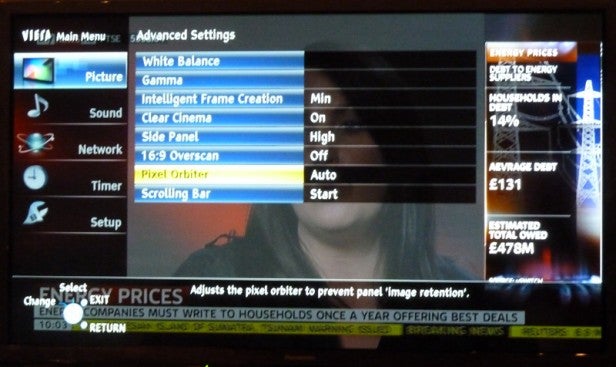
The infrastructure behind the Viera Connect service seems stable and fast, the system already carries some surprisingly high quality games, and there’s potential galore in both the interface and the service’s ability to handle lots of content. In fact, Panasonic has clearly been busy adding content – especially, happily, video content – in the past few weeks. The only catch, really, is that the main app interface remains rather cumbersome.
Picture quality
Settling down to watch the P50ST50 is like meeting up with an old friend. Only the improvements introduced by the new NeoPlasma panel are such that the old friend in question is last year’s step-up GT30 or maybe even flagship VT30 range, rather than the equivalent ST30s.
Particularly gratifying is the P50ST50’s terrific black level response. For as well as delivering deeper black colours than any edge and the majority of direct LED sets, it’s a treat to find absolutely none of the problems with brightness inconsistency you get to some extent on nearly all LED-driven TVs. Here dark scenes look beautifully rich and perfectly uniform right into all four corners of the screen.
Also impressive is the way plasma’s self-emissive technology allows bright colours and light whites to share the screen with deep blacks without the image’s general brightness levels needing to be compromised. This additionally means that shadow detail levels look excellent.
Alongside – and partly thanks to – the outstanding black level performance of the P50ST50, colour handling is excellent. Tones look effortlessly natural for the most part, yet there’s also markedly more punch to the colour palette than there was on last year’s ST30 models.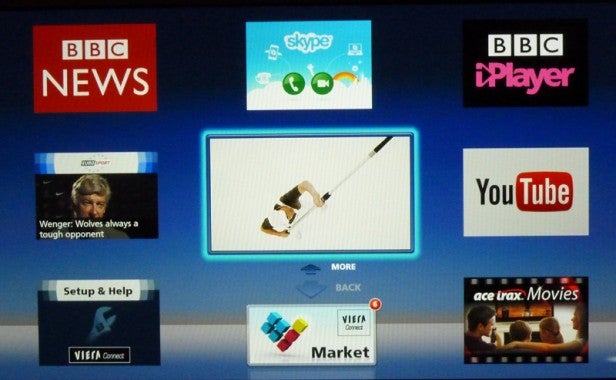
Subtle colour blends and tonal shifts in 2D mode appear for the most part without striping or blotching too, meaning that you get a fulsome display of all the fine detailing and clarity available from high quality HD sources.
Also much-improved from last year’s ST30 range is the Panasonic P50ST50’s motion handling. Even without any motion processing options active, the image seems much less prone to judder. But if you do want to smooth things out further, you can use the lowest setting for the Intelligent Frame Creation system while suffering hardly any unwanted side effects.
Compared with most LCD TVs, moreover, the clarity of the P50ST50’s motion can be considered little sort of exemplary.
HD pictures look exceptionally sharp and detailed, but just as crucially, the TV does a pleasing job of upscaling standard definition sources too. Even a fairly average-quality Freeview standard def channel looks reasonably sharp, at the same time that noise levels are kept reasonably well in check. There are a few colour issues with standard definition, where colours look a touch unbalanced; reds and oranges, in particular, can appear rather ‘blown’. But this issue can be at least reduced via some fairly basic adjustments to the TV’s colour settings.
With the Panasonic P50ST50 also delivering on plasma’s usual advantage when it comes to viewing angles, there’s really only one serious complaint that can be levelled at its 2D pictures: a relative lack of brightness versus your average LED picture. Even using the set’s Dynamic picture preset (which isn’t actually something we’d recommend for 2D viewing) pictures can look somewhat muted if you’re watching them in a sun-drenched/harshly lit room.
In a relatively dark room, though, the lack of brightness becomes a complete non-issue. Indeed, the exceptional depth of the screen’s black level response together with the screen’s ability to show bright and dark image elements simultaneously means images look startlingly dynamic in relatively low light conditions.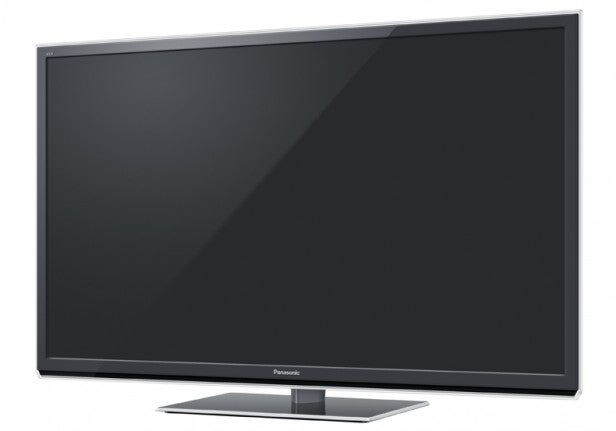
One much smaller issue with the P50ST50’s pictures finds skin tones occasionally and briefly – very briefly – breaking up into fizzing noise if they’re passing quickly across the screen. But as well as being largely limited to standard def viewing, this flaw comes and goes so quickly that it’s almost subliminal.
3D picture quality
Moving to 3D, the P50ST50 also shows serious – and timely, given how much better some 3D LCD TVs have become – signs of improvement. Crosstalk has reduced from “already low” to practically non-existent, for starters. But also notable is how there are fewer issues with colour banding during dark scenes thanks, most likely, to the “2000Hz” system. There’s still a little more banding during, say, the lanterns at night sequence in Chapter 8 of Tangled than you would get with a high quality LED 3D screen, but for the most part we were too busy soaking up the good stuff to notice the minor banding flaws.
Also much improved is the brightness and punch of Panasonic’s plasma 3D images. Admittedly the new glasses still knock out more brightness than arguably any other 3D goggles we can think of, but using the set’s dynamic mode (with colours slightly reined in) the sense of brightness sacrifice when shifting from 2D to 3D isn’t so bad as it was last year, and what you’re watching still looks engaging and dynamic.
Motion is handled better in 3D on the P50ST50 too than it was on last year’s ST30 series, with less judder and greater clarity – whether you employ the ‘24p Smooth Film’ processing (which becomes available when watching Blu-rays) or not.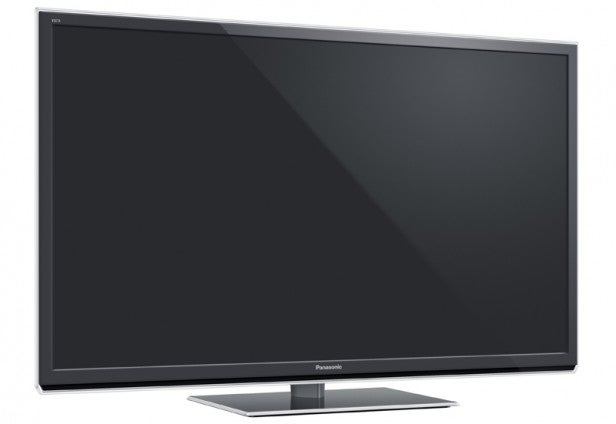
Even using the Dynamic 3D picture preset it’s undeniable that recent 3D pictures from Samsung and LG look a fair bit brighter than those of the P50ST50. But the set’s impressive and consistent black levels during 3D viewing, high levels of detail from 3D Blu-rays and the absence of crosstalk provide ample compensation. Just try, again, to watch 3D films in relatively dark circumstances.
Considering the Panasonic P50ST50 as a gaming screen, so long as you treat it with a little care in its initial few dozen hours of use regarding image retention, it’s a very good display indeed. Using its special Game preset, its contrast-rich pictures work superbly with the likes of the Gears of War and Uncharted titles. Plasma’s freedom from image blur is refreshing too, while input lag measured only around 35ms, which isn’t high enough to significantly damage your gaming performance.
Turning finally to the P50ST50’s audio, it’s actually a touch disappointing. To be fair, its lack of bass and inability to really open up when the going gets tough are common in the flat TV world. But all the talk of a new type of audio system on the P50ST50 had got us hoping for more. Ah well.
Verdict
The Panasonic P50ST50’s in many ways outstanding pictures deliver a salutary reminder in these LED-dominated times of why plasma was first invented. It also reminds us why, for us, a top-notch plasma TV continues to produce the most natural and certainly most cinematic pictures the TV world has to offer.
How we test televisions
We test every TV we review thoroughly over an extended period of time. We use industry standard tests to compare features properly. We’ll always tell you what we find. We never, ever, accept money to review a product.
Trusted Score
Score in detail
-
Features 8
-
3D Quality 9
-
Value 8
-
Design 8
-
2D Quality 9
-
Sound Quality 7
Features
| Size (Inch) | 50in |
| Display Type | Plasma |
| Max. Resolution | 1920 x 1080 |
| Full HD 1080p | Yes |
| Digital Tuner | Yes |
| Freeview HD | Yes |
| 3D Ready | Yes |
| Contrast Ratio | 5,500,000:1 |
| Refresh Rate (Hertz) | 2000Hz |
Connectivity
| HDMI | 3 |
| Component | 1 |
| Composite | 1 |
| Scart | 1 |
| Digital Audio Out | 1 (optical) |
| Headphone | 1 |
| Charging/Computer Connection | 2 |
| Ethernet | 1 |
| WiFi | Yes (built-in) |
Physical Specifications
| Height (Millimeter) | 709mm |
| Width (Millimeter) | 1180mm |
| Depth (Millimeter) | 50mm |
| Weight (Gram) | 23g |

